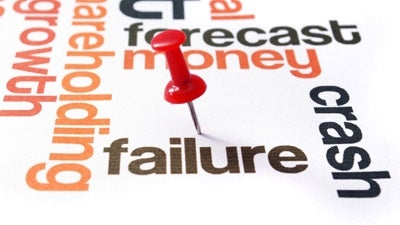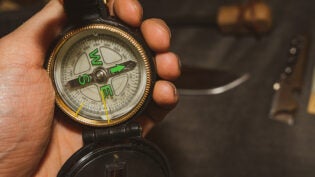Home > Leadership > Strategic Planning >
The No. 1 Enemy of Creativity: Fear of Failure
By: Peter Sims

Never once in my life until my mid 30s did anyone ever (to the best of my recollection) call me “creative.” But now, I hear it all the time.
So what happened?
Well, after a traditional education, business school, and five years working in strategy consulting and venture capital, I went to a cocktail reception at Stanford’s d.school, the Hasso Plattner Institute of Design, where I met George Kembel, cofounder and executive director of the school. While I cannot remember one thing that we discussed, I do remember laughing for about 40 minutes straight as we riffed on odds and ends. (I’ve since learned that anyone who has a sense of humor is creative.)
Over the next five years, what Kembel and his colleagues at the d.school taught me changed the way I thought about everything, leaving me to wonder why the hell I had never learned the basic methods for thinking like a designer (especially in a world where the leading company, Apple, has a culture built around design methods).
For me, the most important insight from design thinking was that you have to make sure you’ve defined the right problem before you try to solve it. So, you act like an anthropologist to understand human needs and problems before jumping to solutions. Most of us in business, if we need to discover how to do something new, use PowerPoint or Excel spreadsheets to rationalize our approach. This is what I call “the illusion of rationality.” Whether motivated by a lack of insight arrogance, or stupidity, the illusion of rationality is a waste of time and resources—yet one that keeps a lot of people employed in management consulting, as I learned first hand.
Instead, if you don’t have the data, you have to create the data. That does not mean plugging random numbers into your spreadsheet. It means generating real insight, from nothing. Designers and bootstrapped entrepreneurs I’ve worked with use rapid low cost experiments to create data. I refer to these “affordable losses” in the interest of learning, creativity, and discovery as “little bets.”
This seems like common sense; so why is it so hard? Three words: fear of failure.
If you’re an MBA-trained manager or executive, the odds are you were never, at any point in your educational or professional career given permission to fail, even on a “little bet.” Your parents wanted you to achieve, achieve, achieve—in sports, the classroom, and scouting or work. Your teachers penalized you for having the “wrong” answers, or knocked your grades down if you were imperfect, according to however your adult figures defined perfection. Similarly, modern industrial management is still predicated largely on mitigating risks and preventing errors, not innovating or inventing.
But entrepreneurs and designers think of failure the way most people think of learning. As Darden Professor Saras Sarasvathy has shown through her research about how expert entrepreneurs make decisions, they must make lots of mistakes to discover new approaches, opportunities, or business models. She frequently references Howard Schultz who, when he started Il Giornale in Seattle, the company that Schultz used to later buy the original Starbucks brand and assets, the store had nonstop opera music playing, menus written in Italian, and no chairs. As Schultz has often said, “We had to make a lot of mistakes” before discovering a model that worked.
So, I ask you: how do you personally define a “failure”?
If it’s going bankrupt with a company you started, getting fired for doing something inconsistent with your values, or needing to break off a wedding engagement or a divorce that could have been avoided if you listened to your heart originally, then, yes, that is a failure, and I can empathize.
However, if your internalized view of failure is anything that is not perfect, then you are disempowering yourself from exercising your inherent creativity.
You’re certainly not the only one shackled by these norms, and I don’t blame you with the way our educational system is focused so rigidly on “correct answers” and standardized testing. This must change. And modern management systems must become far more adaptive.
For instance, at GE, led by Jeff Immelt and Beth Comstock, we are learning in real time with GE’s Innovation Accelerator how an organization long focused on Six Sigma, the antibody of innovation and entrepreneurial discovery, can help its leaders develop a discovery mindset for those situations where there are many unknowns and uncertainties.
Fortunately, the US Army provides a lot of insight about how a highly bureaucratic, command and control organization (the Army of the Cold War) can become more adaptive and creative (which it must when facing rapidly adaptive enemies, and when soldiers and officers can rarely predict what problems they will encounter). It starts with every individual, and unlearning many old bad habits. As Col. Casey Haskins, who heads up military instruction for West Point, has said, “You have to make it cool to fail.” Slow as culture change may come to a behemoth like GE or the military, Comstock, Immelt, and Haskins understand the same insight.
At GE, instead of focusing on completing solutions, Comstock focuses on providing tools and resources to drive a discovery mindset, to identify problems first before jumping in with solutions. And, to do so, they’ve got to change a bunch of internal review approaches so that it becomes cool to be imperfect and half-baked at the early stages of new projects—so long as you’re learning quickly.
One little bet after the other, GE, Cisco, Procter & Gamble, General Mills, Clorox and many other companies are on the path to becoming more adaptive. Amazon and Pixar are leaders already. Bill Hewlett, cofounder of Hewlett Packard, an ardent proponent of what he called “small bet” innovation, found that HP needed to make 100 small bets to find 6 breakthroughs.
Ultimately, while basic design and creative methods can be learned much like muscles, and developed and strengthened through practice, this shift in mindset requires a different kind of leadership. In my opinion, Beth Comstock and Col. Casey Haskins are part of a new breed of leader who have developed and can use both sides of their brain—linear analysis for planning and executing when the decision-making information is known, and a discovery mindset when they must use small bets to create the data.
As the technologist Alan Kay says, “The best way to predict the future is to invent it.”
This article was originally published by Harvard Business Review
Published: October 10, 2013
2523 Views
2523 Views











